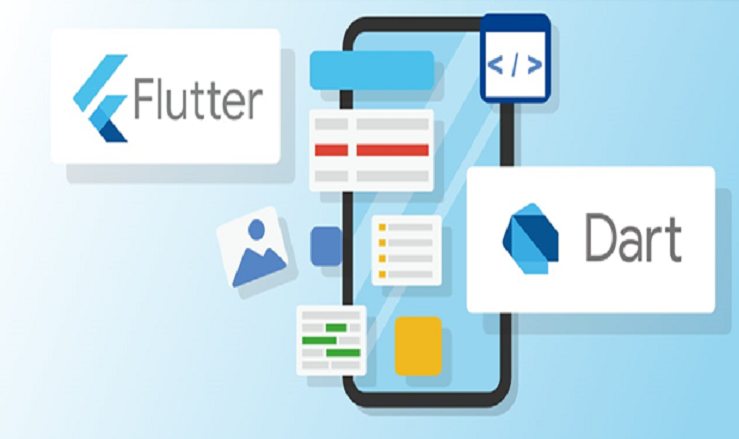To increase the reach and enhance the engagement of your business, you must optimally use the digital platform. You can do it through a mobile app, a desktop app, or a web app.
In recent years, web apps are growing in popularity amongst businesses due to multiple reasons. Web apps can help you to meet your business demands and offer several benefits some of which include the following.
- Convenient to use.
- No installation or maintenance is required by the end-user.
- Require very little space at the end user’s device.
- Similar user experience across multiple platforms.
- It reduces administrative expenses.
- Hot reload feature that accelerates the time to develop codes.
- It always stays updated.
- It can run on multiple platforms.
- Easily customizable and scalable.
There are multiple frameworks through which you can build a web app and among these, Flutter for web created by Google is very popular.
What is Flutter for Web?
Flutter for web, launched by Google is an open-source framework. It is very popular amongst app developers as it allows them to create apps both for Android and iOS platforms with a single code base. Although this framework initially provided the app developers the tools to create cross-platform iOS and Android mobile apps, it has now progressed further and you can also create desktop and web apps with it.
You can divide Flutter for web into two parts:
- SDK: Software Development Kit is an assortment of tools that allows you to create web apps efficiently and in a very short time. Furthermore, it allows you to compile the code into machine code.
- Framework: This widget-based UI library helps you to speed up the web app development process because it allows you to use several reusable UI elements like text inputs, buttons, sliders, and many more.
Things needed to create a web app with the Flutter for web
If you plan to build a Flutter web application, then you should first get the following
- Install Flutter for web SDK on your computer.
- You need a Google Chrome browser to debug the web application.
- You need an Integrated Development Environment like the Visual Studio Code, Android Studio, or IntelliJIDEA for Flutter for Web support.
- Install Flutter for web and Dart plug-ins to get language support and other tools for running, debugging, reloading, and refactoring the web app.
Once you have all these elements in your system, then you are ready to build the app with the help of Flutter for web. To know more let’s dive in!
A detailed guideline to build a Flutter web application
To build a Flutter web app, you have to take the following steps and create a highly functional app that would fulfill all your business needs.
Setup
To start building the web app, you have to first set up Flutter for web on your editor. After the setup is complete, you can run it using any command that you find appropriate. Flutter for web gives you the flexibility of either running the latest version or the earlier stable version.
When you run Flutter for web's last stable version, then it would automatically replace the older version you have in your system and also install all the available updates. Additionally, as you have installed Chrome in your system, the Flutter for web will open the browser when the app is running. It would also run alongside the Web server that would provide the URL for the application.
Understanding the project structure
To create a highly functional app that works seamlessly, you have to carefully look at all those folders and files that you want to include in the project. When you open any web app in Visual Studio Code, you will find that there are multiple folders there. These folders include the following Dart tool, Idea, Android, iOS, lib, build, web and test.
To create a web app, you will be mainly working with the web and lib folders. All the programming files are kept in the lib folder. These files are compiled as per the requirements of the platform that you are targeting. As you are creating a web app, your programming files would be put in the web folder. The index.html file that is placed in the web folder would act as an entry point for the application.
Create and run
Once you have set up all the components, then you can start developing your web app. Creating a new app and running it on Flutter for web is extremely easy. The Flutter app development and deployment time are faster when you compare it with other web app development toolkits available in the market.
You can start developing a new project with a command line or over your IDE. However, the Web support for the hot reload version in Flutter for web is still not provided for in the web browser. Instead of a hot reload, it comes with a hot restart that allows you to launch the app you have created quickly.
Design
According to Pixel Crayons, nearly 38% of the users of your web app will stop their engagement if they find that the content layout is not attractive. Therefore, your web app should not only function smoothly but must look very attractive and should be easy to navigate. For this, you have to be very careful with the designs of the web pages and the UI elements of your web app. These are essential for interactivity with the customers. However, there is no one size fit as web page design and UI elements would vary depending upon the web application type. Therefore, design it depending upon whether your web application is a Fintech, service provider, e-commerce, portfolio, magazine, blog, et cetera.
You must clearly define the intent of the web app so that your users would know upfront about your business when they first open it. The visual hierarchy is a crucial element that helps you to present the information in an easy-to-read and understandable format. This hierarchy includes the color palette, font, format, size, and the positioning of separate elements.
Features to include in your web app
Here are important features that you must include in your web app to make it more useful and also provide the end-users with a great experience with it.
- Use attractive stock or original images for responsive design and user relatability.
- The navigation bar or such box.
- Content to establish brand authority and describe your business to the user.
- Notification system to let your user know about their activity or any new offering from your side.
- A blog site with articles and blogs for in-house writers or guest writers on relevant topics.
- An analytical dashboard to analyze the user activity.
- A robust content management system for your content-heavy web application.
Rendering
Whenever you create any application within Flutter, it would automatically choose the web renderer. For example, an application that runs through the HTML renderer when it is operating through a mobile browser. On the other hand, it can seamlessly run with the Canvastik when it is on the desktop browser. This suggested configuration helps to maintain cross-platform consistency. You can easily change it according to your unique requirements.
Testing
Once you have developed the web app, then it is time for the test to weed out any bugs. Flutter for web gives you a very robust and easy testing option to check the web app before you deploy it. First of all, you have to run the code of the web app to test it by targeting the Google Chrome platform. The moment you give the command, the web application will automatically compile and run on the browser.
Deploying
Once the web application is fully ready to be deployed, you have to release the app bundle over a well-known hosting service so that it gives you amazing speed and performance. Some of the important hosting services that the Flutter for web framework recommends include Github pages, Firebase hosting, and Google Cloud hosting.
Conclusion
As the developers became more aware of the benefits of Flutter for web, its popularity is also growing for building Web apps. This improved acceptance of this framework to build business apps is directly related to its ability to provide more business values.
Therefore, you can use this amazing framework to develop web apps that fit perfectly with your business strategy and help you reach your strategic goals. So, hire some highly-experienced flutter app developers and build a web app for your business needs effortlessly.


